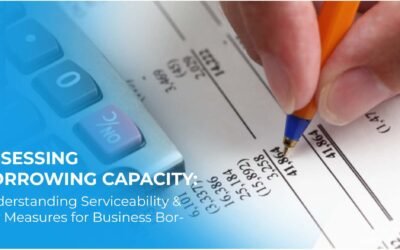Business Lending – Understanding Serviceability and Covenant Ratios.

Business Lending – Understanding Serviceability and Covenant Ratios
When it comes to business lending, assessing the borrowing capacity and serviceability of a business borrower is crucial. Lenders use various measures to evaluate a business’s ability to meet debt obligations and repay loans. In this blog post, we will explore key measures such as Interest Cover Ratio (ICR), Debt Service Ratio (DSR), and Multiple of Earnings. Additionally, we’ll delve into covenants and ratios that lenders impose on borrowers to monitor performance and ensure compliance.
Assessing Borrowing Capacity: Key Measures
Interest Cover Ratio (ICR)
The ICR measures a business’s ability to pay interest on its outstanding debt. We’ll discuss how this ratio is calculated and why a ratio below 2.0 may raise concerns about meeting interest commitments.

Debt Service Ratio (DSR)
The DSR evaluates a business’s ability to repay all debt obligations. We’ll explain how this ratio considers the actual cash commitment to reducing debt, and why a ratio of 1.0 or lower indicates negative cash flow.
Multiple of Earnings
Applying a multiple to the adjusted EBITDA helps determine borrowing capacity, particularly for service firms. We’ll explore how this method considers consistent EBITDA and lending without tangible security.
Covenants and Ratios
Monitoring Performance Covenants are restrictions or requirements imposed by lenders to monitor borrower performance. We’ll discuss the significance of covenants and how they can be quantitative or qualitative, positive or negative.
Debt/EBITDA Ratios
Debt/EBITDA ratios are commonly used covenants. We’ll explain how lenders evaluate this ratio and its importance in assessing a business’s financial health and risk.

Interest Coverage Ratios
Interest coverage ratios help determine a business’s ability to cover interest payments. We’ll discuss the calculation and its role in assessing a business’s ability to meet its interest obligations.
Debt/Equity
The debt/equity ratio measures the proportion of a business’s debt relative to its equity. We’ll explore how this ratio provides insights into a business’s financial leverage and risk exposure.
EBITDA
Lenders may impose covenants based on EBITDA, a measure of a business’s operating performance. We’ll explain how EBITDA covenants ensure the business’s financial stability and ability to generate sufficient cash flow.
Importance of Compliance and Monitoring
We’ll emphasize the importance of business owners’ financial literacy in understanding and complying with covenants. Regular monitoring of financial performance is essential to prevent covenant breaches and maintain a well-run business.
Conclusion
Assessing serviceability and understanding covenant ratios are crucial for business owners seeking lending opportunities. By evaluating measures like ICR, DSR, and Multiple of Earnings, borrowers can determine their borrowing capacity and understand the financial obligations involved. Furthermore, complying with covenants and regular monitoring ensures a business remains on track and in good standing with lenders.
Book a meeting with us today. Our team will work closely with you to assess your financial position, understand your industry experience, and help you secure the financing necessary to fuel your business growth.
Disclaimer: The information provided in this blog is for educational purposes only and should not be considered financial advice. Always consult with a professional financial advisor or lender for specific lending decisions.





